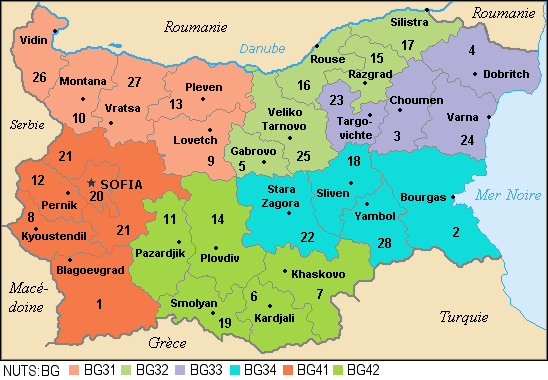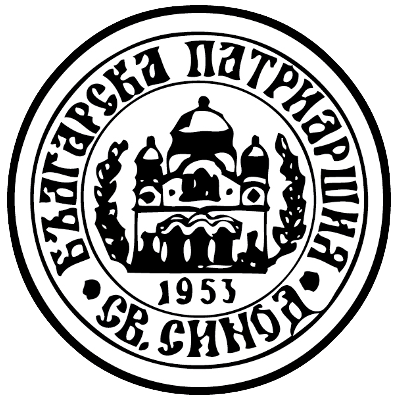|
Chavdar, Sofia Province
Chavdar ( bg, Чавдар, ) is a village situated in a mountain region, in the eastern part of Sofia Province, Bulgaria. It is the administrative center of Chavdar Municipality. The municipality is located in the sub-Balkan Zlatitsa-Pirdop Basin. It consists of only one village, namely the village of Chavdar. The municipality is one of the smallest in Bulgaria, situated at the southern outskirts of the Balkan Mountains, and on the northern foothills of Sredna Gora mountain. It is located about 72 km (45 miles) east of Sofia, the capital city of Bulgaria. Close by are the cities of Zlatitsa and Pirdop. History Prehistoric time Ever since prehistoric times the land of present time Chavdar has been populated by people. Archaeological excavations of a settlement mound near the Topolnitsa River show that a Neolithic community has been present as early as 7,000 years ago. The study of Neolithic culture "Chavdar" began in May 1968. Professor Georgi Georgiev and Senior Resear ... [...More Info...] [...Related Items...] OR: [Wikipedia] [Google] [Baidu] |
Provinces Of Bulgaria
The provinces of Bulgaria ( bg, области на България, oblasti na Bǎlgarija) are the first-level administrative subdivisions of the country. Since 1999, Bulgaria has been divided into 28 provinces ( bg, области, links=no – ''oblasti;'' singular: – ''oblast''; also translated as "regions") which correspond approximately to the 28 districts (in bg, links=no, окръг – ''okrug, okrǎg'', plural: – ''okrǎzi''), that existed before 1987. The provinces are further subdivided into 265 municipalities (singular: – ''obshtina'', plural: – ''obshtini''). Sofia – the capital city of Bulgaria and the largest settlement in the country – is the administrative centre of both Sofia Province and Sofia City Province (Sofia-Grad (toponymy), grad). The capital is included (together with three other cities plus 34 villages) in Sofia Capital Municipality (over 90% of whose population lives in Sofia), which is the sole municipality comprising Sofia City ... [...More Info...] [...Related Items...] OR: [Wikipedia] [Google] [Baidu] |
National Archaeological Museum (Bulgaria)
The National Archaeological Museum ( bg, Национален археологически музей, ''Natsionalen arheologicheski muzey'') is an archaeological museum in the centre of Sofia, the capital of Bulgaria. It occupies the building of the largest and oldest former Ottoman mosque in the city, originally known as Koca Mahmut Paşa Camii. The construction started in 1451 under grand vizier Veli Mahmud Pasha but due to his death in 1474 the mosque has been completed in 1494. The museum was established as a separate entity in 1893 as the National Museum directed by Czech Václav Dobruský with its headquarters in the former mosque that previously housed the National Library between 1880 and 1893. The museum was officially opened and inaugurated in 1905, as by then all archaeological exhibits previously kept all over the city were moved there, in the presence of Knyaz Ferdinand of Bulgaria and Minister of Enlightenment Ivan Shishmanov. Several additional halls and adminis ... [...More Info...] [...Related Items...] OR: [Wikipedia] [Google] [Baidu] |
Protestantism In Bulgaria
Protestantism is a branch of Christianity that follows the theological tenets of the Protestant Reformation, a movement that began seeking to reform the Catholic Church from within in the 16th century against what its followers perceived to be growing errors, abuses, and discrepancies within it. Protestantism emphasizes the Christian believer's justification by God in faith alone (') rather than by a combination of faith with good works as in Catholicism; the teaching that salvation comes by divine grace or "unmerited favor" only ('); the priesthood of all faithful believers in the Church; and the ''sola scriptura'' ("scripture alone") that posits the Bible as the sole infallible source of authority for Christian faith and practice. Most Protestants, with the exception of Anglo-Papalism, reject the Catholic doctrine of papal supremacy, but disagree among themselves regarding the number of sacraments, the real presence of Christ in the Eucharist, and matters of ecclesiastical ... [...More Info...] [...Related Items...] OR: [Wikipedia] [Google] [Baidu] |
Catholicism In Bulgaria
The Catholic Church is the fourth largest religious congregation in Bulgaria, after Eastern Orthodoxy, Islam and Protestantism. Its roots in the country date to the Middle Ages and are part of the worldwide Catholic Church, under the spiritual leadership of the Pope in Rome. Location and number In the Bulgarian census of 2011, a total of 48,945 people declared themselves to be Catholics, up from 43,811 in the previous census of 2001 though down as compared to 53,074 in 1992. The vast majority of the Catholics in Bulgaria in 2001 were ethnic Bulgarians and the rest belonged to a number of other ethnic groups such as Croatians, Italians, Arabs and Germans. Bulgarian Catholics live predominantly in the regions of Svishtov and Plovdiv and are mostly descendants of the heretical Christian sect of the Paulicians, which converted to Catholicism in the 16th and 17th centuries. The largest Catholic Bulgarian town is Rakovski in Plovdiv Province. Ethnic Bulgarian Catholics known as the B ... [...More Info...] [...Related Items...] OR: [Wikipedia] [Google] [Baidu] |
Bulgarian Orthodox Church
The Bulgarian Orthodox Church ( bg, Българска православна църква, translit=Balgarska pravoslavna tsarkva), legally the Patriarchate of Bulgaria ( bg, Българска патриаршия, links=no, translit=Balgarska patriarshiya), is an autocephalous Orthodox jurisdiction. It is the oldest Slavic Orthodox church, with some 6 million members in Bulgaria and between 1.5 and 2 million members in a number of European countries, the Americas, Australia, New Zealand and Asia. It was recognized as autocephalous in 1945 by the Ecumenical Patriarchate of Constantinople. History Early Christianity The Bulgarian Orthodox Church has its origin in the flourishing Christian communities and churches set up in the Balkans as early as the first centuries of the Christian era. Christianity was brought to the Balkans by the apostles Paul and Andrew in the 1st century AD, when the first organised Christian communities were formed. By the beginning of the 4th ce ... [...More Info...] [...Related Items...] OR: [Wikipedia] [Google] [Baidu] |
Vasil Radoslavov
Vasil Hristov Radoslavov ( bg, Васил Христов Радославов) (27 July 1854 – 21 October 1929) was a leading Bulgarian liberalism, liberal politician who twice served as List of Prime Ministers of Bulgaria, Prime Minister. He was Premier of the country throughout most of World War I. Biography Born in Lovech, Radoslavov studied law at Ruprecht Karl University of Heidelberg, Heidelberg and became a supporter of Germany from then on. He became a political figure in 1884 when he was appointed Minister of Justice in the cabinet of Petko Karavelov, also holding the position under Archbishop Kliment Turnovski. He succeeded Karavelov as Prime Minister in 1886 and being aged 32 years, was the youngest person to have ever been Prime Minister of Bulgaria. Additionally he was the Ministry of Finance (Bulgaria), Minister of Finance. His brief reign was marked by corruption and ultimately led to a split in the Liberal Party, with a Liberal Party (Radoslavists), Radosla ... [...More Info...] [...Related Items...] OR: [Wikipedia] [Google] [Baidu] |
Liberal Party (Radoslavists)
The Liberal Party ( bg, Либерална партия, ''Liberalna partiya''), also known as the Radoslavists ( bg, радослависти) was a political party in Bulgaria from 1887 until 1920. History The party was established by Vasil Radoslavov as a splinter from the People's Liberal Party (PLP) in 1887,RJ Crampton (2007) ''Bulgaria'', Oxford University Press, p451 going on to lose to the PLP in the elections that year."The Bulgarian Question", ''The Times'', 12 October 1887 The 1894 elections saw the party win 27 seats. During 1899 the party briefly merged with the PLP to form the United Liberal Party, but the two separated again later in the year. In April 1899 it won an absolute majority in the National Assembly with 89 of the 169 seats.Dieter Nohlen & Philip Stöver (2010) ''Elections in Europe: A data handbook'', p384 However, the party was reduced to just five seats in the 1901 elections. It won seven seats in 1902 and nine in 1903. In 1904 a group of members ... [...More Info...] [...Related Items...] OR: [Wikipedia] [Google] [Baidu] |
Chavdar Village Hall
Chavdar may refer to: Places * Chavdar Municipality, Sofia Province, Bulgaria * Chavdar, Sofia Province, a village in Bulgaria * Chavdar, Smolyan Province, a village in Bulgaria * Chavdar Peninsula, Antarctica People with the given name * Chavdar Atanasov (born 1973), Bulgarian footballer * Chavdar Djurov (1946–1972), Bulgarian pilot and skydiver * Chavdar Tsvetkov (born 1953), Bulgarian footballer * Chavdar Voyvoda, 16th-century Bulgarian rebel leader * Chavdar Yankov (born 1984), Bulgarian footballer * Tchavdar Georgiev is a writer, US producer, director and editor of films Other uses * Chavdar (company), a Bulgarian coachbuilder * Chavdar Partisan Brigade, a Bulgarian partisan group of World War II * PFC Chavdar Byala Slatina, a Bulgarian football club * PFC Chavdar Etropole, a Bulgarian football club See also * Chavdartsi (other) Chavdartsi refers to the following places in Bulgaria: * Chavdartsi, Lovech Province * Chavdartsi, Veliko Tarnovo Province See al ... [...More Info...] [...Related Items...] OR: [Wikipedia] [Google] [Baidu] |
Dobreyshovo Gospels
Dobreyshovo gospel is a Bulgarian monument of the early 13th century. Description The manuscript is ink and illumination on a total of 175 parchment leaves. It is located at the SS. Cyril and Methodius National Library, Bulgaria. History The Gospel was written, according to a much later note added to it, before 1221, according to the scholars Wolf and Stresa. It is decorated with colorful ornamentation and images of the Evangelists Luke and John. The latter appears with a small kneeling figure, accompanied by the caption "pray to St. John"; the figure is believed to represent the priest Dobreysho (or Dobreisho), who probably paid for the parchment and either commissioned or made a copy of the book.Пуцко, В. О ''портретном изображении попа Добрейша. – Старобългаристика'', 9, 1985, № 3, 65-73. The manuscript was found in Tulcea, Romania. Records indicate that it earlier was in Edirne. The majority of it (127 sheets) ... [...More Info...] [...Related Items...] OR: [Wikipedia] [Google] [Baidu] |
Karanovo Culture
The Karanovo culture is a Neolithic culture (Karanovo I-III ca. 62nd to 55th centuries BC) named after the Bulgarian village of (Караново, Sliven Province ). The culture, which is part of the Danube civilization, is considered the largest and most important of the Azmak River Valley agrarian settlements. Discovery Archaeologists discovered the Karanovo settlement in the 1930s when a tell - a settlement mound - was excavated at Karanovo. The hilltop settlement is constituted of 18 buildings, which housed some 100 inhabitants. The site was inhabited more or less continuously from the early 7th to the early 2nd millennia BC. The Karanovo culture served as the foundation of the East Balkan cultural sequence. The layers at Karanovo are employed as a chronological system for Balkans prehistory. This culture had seven major phases: Karanovo I and II, which existed parallel to Starčevo; Karanovo III (Veselinovo); Karanovo IV; Karanovo V (Marica); Karanovo VI (Gumelniţ ... [...More Info...] [...Related Items...] OR: [Wikipedia] [Google] [Baidu] |
Bulgaria 6200BC Neolithic Chavdar Culture
Bulgaria (; bg, България, Bǎlgariya), officially the Republic of Bulgaria,, ) is a country in Southeast Europe. It is situated on the eastern flank of the Balkans, and is bordered by Romania to the north, Serbia and North Macedonia to the west, Greece and Turkey to the south, and the Black Sea to the east. Bulgaria covers a territory of , and is the sixteenth-largest country in Europe. Sofia is the nation's capital and largest city; other major cities are Plovdiv, Varna and Burgas. One of the earliest societies in the lands of modern-day Bulgaria was the Neolithic Karanovo culture, which dates back to 6,500 BC. In the 6th to 3rd century BC the region was a battleground for ancient Thracians, Persians, Celts and Macedonians; stability came when the Roman Empire conquered the region in AD 45. After the Roman state splintered, tribal invasions in the region resumed. Around the 6th century, these territories were settled by the early Slavs. The Bu ... [...More Info...] [...Related Items...] OR: [Wikipedia] [Google] [Baidu] |






